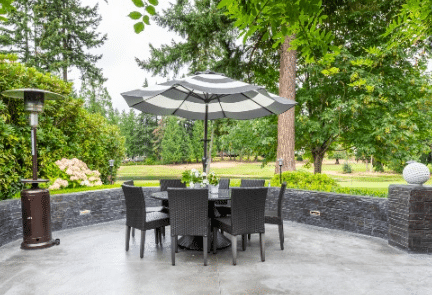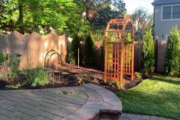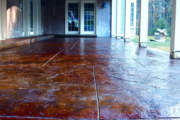Why Stamped Concrete Beats Pavers In Lemon Grove?

- Stamped concrete costs much less than interlocking pavers in both materials and installation. It is also more cost-effective in the long run because it requires minimal maintenance once installed.
- Stamped concrete can be patterned to resemble brick, slate, flagstone, tile, or any other type of paving surface while still providing a strong foundation that will last for years to come. It also comes in many different colors and patterns, giving homeowners plenty of options to choose from.
- Stamped concrete is incredibly durable and can withstand extreme weather conditions without cracking or shifting. It is also non-slip and resistant to staining, making it a great choice for outdoor areas that are prone to rain or snow.
- Unlike pavers which require regular cleaning and sealing, stamped concrete requires very little maintenance once installed. All it needs is an occasional sweep or hose down to keep it looking new for years to come.
- Installation time for stamped concrete is much shorter than that of interlocking pavers, which can take days to complete depending on the size of the area. Stamped concrete can be completed in a matter of hours, giving homeowners more time to enjoy their outdoor space.
FAQ’s
What Is The Advantage Of Stamped Concrete?
The main advantage of stamped concrete is its versatility and low-maintenance requirements. It is a cost-effective option that can last for years to come, with minimal upkeep required once installed. Stamped concrete also comes in many different colors and patterns, giving homeowners plenty of design options to choose from.
How To Cure Cracks In Concrete Slabs?
To cure cracks in concrete slabs, it is important to understand the underlying causes of the cracks and implement appropriate repair techniques. Before attempting any repairs, identify the cause of the cracks. Common causes include shrinkage due to drying, settlement, frost heave, or excessive loads. Understanding the cause will help determine the appropriate repair method. Remove any loose debris or old filler from the crack using a wire brush, chisel, or compressed air. It is essential to have a clean and properly prepared crack for effective repair. Select an appropriate filler based on the size and type of crack. For hairline cracks, use a liquid crack filler or epoxy injection. For larger cracks, use a concrete patching compound or a hydraulic cement-based product. Follow the manufacturer’s instructions to apply the chosen filler. For liquid crack fillers or epoxy injections, use a syringe or pour the material directly into the crack. For patching compounds, use a trowel to fill the crack and level it with the surrounding surface. Curing is a critical step in the repair process. Ensure the repaired area is protected from moisture, extreme temperatures, and excessive traffic. Follow the curing time specified by the manufacturer to allow the filler to harden and bond effectively. To prevent future cracks and protect the repaired area, consider applying a concrete sealer. Sealing the surface creates a protective barrier against moisture and helps maintain the structural integrity of the concrete slab. After repairing the cracks, take preventive measures to minimize the chances of future cracks. This includes controlling moisture levels, avoiding heavy loads, maintaining proper drainage, and addressing any underlying issues that may have caused the cracks.
Is Stamped Concrete Slippery?
No, stamped concrete is non-slip and resistant to staining. This makes it an ideal choice for outdoor areas prone to rain or snow, as it won’t become slippery when wet. It is also resistant to cracking or shifting due to extreme weather conditions.
Can You Install Decorative Concrete For Your Living Area?
Yes, you can definitely install decorative concrete for your living area. Decorative concrete is a versatile and popular choice for enhancing the aesthetic appeal of various indoor and outdoor spaces, including living areas. It offers a wide range of design options, durability, and low maintenance requirements, making it an attractive choice for homeowners. Decorative concrete can be used to create stunning flooring solutions for your living area. With the help of various techniques such as staining, stamping, and polishing, concrete can be transformed into beautiful and unique designs that mimic the look of natural stone, tile, or even wood. Whether you prefer a sleek and modern appearance or a more rustic and traditional look, decorative concrete can be customized to suit your personal style and preferences. One of the advantages of using decorative concrete is its durability. Concrete is known for its strength and longevity, making it an excellent choice for high-traffic areas like living rooms. It can withstand heavy foot traffic, furniture movement, and daily wear and tear without losing its aesthetic appeal. Additionally, decorative concrete is resistant to stains, spills, and fading, ensuring that your living area maintains its beauty for years to come. Maintenance is another key benefit of decorative concrete. Unlike other flooring options that require regular sealing, waxing, or polishing, decorative concrete is relatively low maintenance. Simple cleaning with mild soap and water is usually sufficient to keep it looking great. This makes it a convenient choice for busy households or individuals who prefer easy-to-maintain flooring solutions. When considering the installation of decorative concrete in your living area, it’s essential to hire professional contractors with experience in decorative concrete work. They can guide you through the design options, provide expert installation, and ensure that the concrete is properly sealed and finished to enhance its longevity and appearance.
How Long Does Stamped Concrete Last?
Stamped concrete can last for decades with proper maintenance and care. Its durability and low-maintenance requirements make it a great choice for outdoor areas that will see lots of foot traffic. This is why stamped concrete is becoming an increasingly popular choice for driveways, patios, and walkways.
Conclusion
For those looking for an affordable and durable paving material for their outdoor spaces, stamped concrete is an excellent choice. Not only does it come in a variety of colors and patterns, but it is also easy to install and maintain. For more information, contact Concrete Contractor Lemon Grove at (619) 648-5335.

